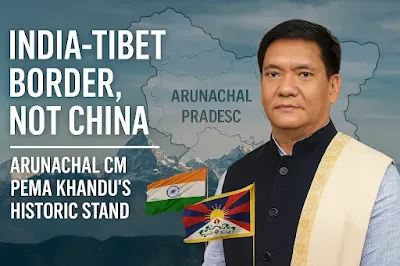India-Tibet Border, Not China: Arunachal CM Pema Khandu’s Bold Statement Explained
Arunachal Pradesh Chief Minister Pema Khandu recently reignited an important geopolitical discussion by stating,India does not share a border with China. We share our border with Tibet.This assertion has sparked a fresh wave of attention toward the region's historical realities, questioning China’s current territorial claims and underlining India’s position on Tibet.
The Historical Background: What Was Tibet?
Before 1950, Tibet was an independent nation with its own government, flag, currency, and diplomatic relations. India maintained trade and cultural ties with Tibet for centuries, and several Himalayan states, including Arunachal Pradesh, considered Tibet their neighbor.
However, in 1950, the People’s Republic of China invaded Tibet and formally annexed it in 1951. Since then, Tibet has remained under Chinese occupation — but its sovereignty remains a matter of international debate, especially among Tibetan exiles and activists.
Arunachal Pradesh shares a 1,129 km-long border — not with mainland China, but with the Tibet Autonomous Region (TAR). This border is defined by the McMahon Line, drawn during the 1914 Simla Convention between British India and Tibet.
China, however, does not recognize this line and refers to Arunachal Pradesh as “South Tibet,” further complicating the situation. But from both historical and geographical perspectives, India’s border is with Tibet, not with the Chinese heartland.
Pema Khandu's remarks:
Challenge China's narrative on Arunachal Pradesh.
Reaffirm India’s cultural and historic ties with Tibet.
Reinforce the position of many scholars and Tibetans who view the annexation of Tibet as illegal.
Signal a more assertive diplomatic tone in response to China's repeated border incursions.
This also aligns with the Indian Parliament's 1962 stance during the Indo-China war, where the issue was framed as Chinese aggression through Tibet, not China directly invading Indian land.
International Implications
Many global observers and nations have begun recognizing the complexity of China's claims in Tibet, Xinjiang (East Turkestan), Inner Mongolia, and Hong Kong. The growing movement to recognize Chinese-occupied regions adds momentum to such bold statements from political leaders like Pema Khandu.
India’s northeastern state of Arunachal Pradesh remains a symbol of India's historical ties with Tibet. Chief Minister Pema Khandu's statement isn’t just rhetoric — it’s a reminder of suppressed histories, unresolved occupations, and a challenge to the global narrative.




